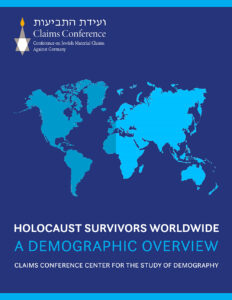More Black storytellers are turning to the horror genre to unpack the traumas of racism. But some viewers are growing tired of these stories.
Updated at 6:40 p.m. ET on April 17, 2021.
In the trailer for Amazon’s new horror series, Them, Diana Ross’s “Home” soundtracks a tender scene: A Black husband and wife in the 1950s survey their new house in wonder and dance in the living room with their two daughters. “When I think of home / I think of a place where there’s love overflowing,” Ross sings. But, as in the song, the tenor of the trailer changes. We learn that the Emory family has moved to a white part of Compton, where residents don’t take kindly to the demographic shift. “They came from someplace worse. We’ll have to make this place worse,” one neighbor says. A montage of racist harassment follows: White classmates make ape noises at one Emory daughter; golliwog dolls hang from the family’s roof; a church is set ablaze.
In response to the trailer, many Black viewers lamented what they saw as an industry pattern of exploiting Black pain. “Black trauma is just entertainment for black hollywood filmmakers and white execs,” the writer Berneta L. Haynes tweeted, echoing criticisms aimed at other recent horror works such as the HBO series Lovecraft Country and the film Antebellum. The outcry only grew after Them, created by Little Marvin and executive produced by Lena Waithe,premiered last weekend. In a pan for Vulture, Angelica Bastién called the show “one of the most anti-Black pieces of pop culture” she had seen in recent years. For NPR, Aisha Harris argued that “Them suffers from the same predicament that has arisen in the wake of Black people becoming hashtags in death—the public knows far more about their last moments on Earth than all the moments that made up their life before.”
Many of the specific scenes that Bastién, Harris, and other critics reference are indeed gratuitous and upsetting. Much of the terror that Them’s Black characters experience—sexual assault, murder, racist slurs—is heavy-handed, without the benefit of clear supernatural elements to blunt some of its force. (More on the show later.) But beyond the particulars of Amazon’s clumsy new offering, these criticisms point to an underlying fatigue with pop culture in which the villain is racism itself. This fatigue has fueled a kind of genre creep, in which works of horror are grouped with productions as formally disparate as historical dramas about slavery and contemporary road-crime films under the impossibly broad banner of “Black trauma porn.” At its most reductive, this framing risks penalizing Black horror for a genre hallmark: graphic depictions of violence.
Still, as Harris notes, such depictions can never be fully divorced from the world they exist in. Them debuted during the still-ongoing trial of the former Minnesota police officer Derek Chauvin for the murder of George Floyd. The weekend the show premiered, police in the same state killed 20-year-old Daunte Wright during a routine traffic stop. In addition to the video footage of Floyd’s and Wright’s deaths, the past decade has been filled with nearly inescapable images of anti-Black violence, scenes that have no narrative purpose, no resolution. As the horror scholar Tananarive Due told me, “Living with the reality that someone could arbitrarily kill you in broad daylight with witnesses and there would be no justice … is sort of a living, breathing horror.” Given the relentlessness of those daily threats, it’s no wonder that many Black viewers in America aren’t keen on watching a series they feel turns their daily fears into entertainment.
Black horror thus faces a distinct paradox: The genre has long been a valuable tool for creators of different backgrounds to process their traumas, and for audiences to reckon with their own. Some Black writers and producers in America use horror and science fiction as a lens through which to examine the grotesquerie of the country’s racist systems and history (Jordan Peele, for example, made Get Out after the killing of Trayvon Martin). But productions that engage with that real-life terror can, at times, feel more like brutal reenactments of senselessnessthan purposeful works of art, unintentionally compounding some Black viewers’ traumas. “Horror is one of those genres where you can have a movie where everybody dies at the end,” said Due, the executive producer of the 2019 documentary Horror Noire and a lecturer at UCLA. “But as a Black horror artist, I have to ask myself, Who would that be for?” As more Black creators in Hollywood get the chance to tell horror stories following decades of exclusion, this paradox is going to become only more pronounced.
Historically, genre works by white creators tend not to raise questions of intended audience in the same way that works by Black storytellers do. That’s part of the banal reality of white supremacy in Hollywood, which positions white viewers, and white characters, as the default. For instance, a slasher film featuring white protagonists can be viewed on its own terms. But works by Black creators (such as the recent Netflix sci-fi short film Two Distant Strangers) invite more speculation about what social critique their creators are attempting to convey, and on whose behalf, regardless of authorial intent. In the case of Them, the sheer intensity and meaninglessness of the cruelty on display lends credence to arguments that Little Marvin didn’t anticipate how the show might affect Black audiences, many of whom view it as a bloodied funhouse mirror of an already-horrifying reality.
Black artists in America have been imbuing stories of quotidian terror with supernatural elements for more than a century. As Due noted, W. E. B. Du Bois published a short science-fiction story, “The Comet,” in 1920 alongside the essays in his Darkwater collection. The story follows a Black man who saves a white woman amid natural disaster—and still ends up having to fear that her family will lynch him afterward. Many films in the first half of the 20th century depicted Black people as monstrous figures haunting white people, but that slowly began to change in the ’60s and ’70s. George A. Romero’s 1968 Night of the Living Dead cast Duane Jones as its lead, frequently identified as the first Black man to play a hero in a horror movie. Following a suite of flashy blaxploitation releases, Rusty Cundieff’s 1995 anthology film, Tales From the Hood, tied together short horror tales through the experience of three drug dealers meeting a funeral director. In quick succession, the movie tackled racist policing, the Ku Klux Klan, and gang violence; it also became a cult classic. But it took the success of Get Out to open the door for Cundieff’s sequel more than 20 years later.
The enormous success of Peele’s film, which won the 2018 Oscar for Best Original Screenplay and grossed $255 million globally, brought industry-wide attention to horror and science fiction made by Black creators, who were finally seeing institutional support and larger audiences. In recent years, studios have announced a Candyman sequel from Nia DaCosta, the TV adaptation of Lovecraft Country from Misha Green, Peele’s Us and his CBS Twilight Zone reboot, and others.
The notion that many viewers are already tired of Black horror about racism is alarming to Due, who has been publishing horror fiction since 1995 and wrote the introduction to Get Out’s annotated screenplay. “We just kicked the door open,” she said. “I always tell my students, it feels like the current renaissance we’re seeing right now with Black horror and also science fiction … started just five minutes ago.” To her, it’s too early to be exhausted by a body of work that’s still finding its groove. “We’re just pulling out of that muck of misrepresentation and invisibility,” she said of Black people’s role in horror more broadly. At the same time, Due recognizes that many stories will understandably drive Black viewers away.
Indeed, I was apprehensive about diving into Them, even before the most recent cycle of police-brutality-related news. Quite frankly, I am tired. But the series does have some high points. Them is visually stunning, and its portrait of 1950s Compton is full of rich hues, and the Emory family is lit to bring out the depth of all the actors’ skin tones. Danger creeps in slowly at first, beginning in the pilot when Lucky Emory (played by Deborah Ayorinde) sees a disclaimer on the mortgage for the house that her husband, Henry (Ashley Thomas), has chosen for their family: No one with “Negro blood” is to occupy the home.
Unlike horror works that grapple with racism in its myriad forms, Them is animated by a specific manifestation—housing segregation—which gives the story both narrative and spatial focus. Little Marvin’s portrayal of the laws that enforced housing segregation is meticulous. Soon after the Emorys arrive in Compton, terror begins to emanate from and surround their suburban home. When the younger Emory daughter, Gracie (Melody Hurd), sensed a strange figure living in the house, I hoped Them would tie in elements of Black American lore about “haints”—the Southern-tradition ghosts that also appear in fictional works such as Angela Flournoy’s The Turner House.
But instead of deepening its story with thoughtful references to past works of Black horror, Them’s most unnerving scenes feature everyday 1950s racism or add only small genre tweaks to it. White people gather to discuss their neighborhood’s “Negro problem”; police officers threaten to run the Emorys out by any means necessary; minstrel performers surprise Henry at work. At one point, neighbors pour gasoline on the Emorys’ lawn and set it on fire. When the camera zoomed out, I expected to see the familiar shape of a burning cross etched into the grass, but Them did manage to surprise me. Instead, the flames spelled out a whole phrase: NIGGER HEAVEN.
I knew then that Them would be painful to watch not just because of its excessive violence, but also because it lacks any real subtlety or storytelling finesse. The show’s most contentious scene comes later, though, in its fifth episode, when white strangers simultaneously murder a Black infant and rape his mother. Notably, the episode is the only one directed by a Black person, Janicza Bravo, also the director of A24’s upcoming film Zola. Another wave of online reactions was sparked by a Los Angeles Times interview with Little Marvin that described some of the show’s most disturbing sequences, including the blinding and subsequent burning of a Black couple. (Although a lot of criticism on social media has been aimed at Waithe, who wrote the screenplay for the much-maligned Queen & Slim, she didn’t write or direct any installments.*)
It’s hard to imagine any work, even a horror series, that could portray such spectacular anti-Black violence with nuance or grace. Though horror has been used to address the trauma of sexual assault in the past, especially in women-led productions, the specifics of Them’s murder-rape scene don’t cohere into a cathartic rendering simply because someone like Bravo is behind the lens. As Due told me, some of the smartest and most empathetic creators are especially mindful of how they portray physical harm enacted upon Black characters. In other words, it matters how creators deploy violence, not just whether it exists at all. Paraphrasing something that Peele himself once said, Due told me that creators should ask themselves whether anti-Black violence in their works feels “necessary and redemptive to the storytelling.”
Unfortunately, too many recent works have failed to live up to that ideal. HBO’s overwrought Lovecraft Country (co–executive produced by Peele) deployed the literal monsters written by its bigoted namesake to both symbolize and enact Jim Crow–era racism, as I wrote last year. With its blend of monsters and magic, the show promised viewers fantastical catharsis, if not outright escapism. And yet, itended by visiting an onslaught of violence with no real narrative value upon its Black characters. Last fall’s plantation-horror film Antebellum subjected its protagonist, Eden (Janelle Monáe), to even worse cruelty, flinging her from modern-day life to a setting meant to replicate the pre–Civil War South. As my colleague David Sims wrote, “The first 40 or so minutes of Antebellum are a ceaseless torrent of violence and abuse … The terrifying realities of slavery are reduced to horror-movie tropes.” Like Them, Antebellum points out the connections between historical and contemporary racism but has little else to say.
By contrast, Get Out shows how Black horror can effectively combine gore and visceral commentary on race. The film indulges in genre tropes, to be sure, but it exercises caution in dealing physical trauma to Black characters. Crucially, it offers new visual language for discussing familiar subjects: The phrase the Sunken Place now functions as shorthand for a kind of everyday racist dystopia. Other beloved works, such as Leprechaun in the Hood and Bones, lean so far into their comedic elements that they soften the onscreen violence.
While watching the most merciless moments of Them, moments in which pure racist violence is more menacing than any supernatural element, I found myself thinking not just about other Black viewers’ exasperation but also about something the director Nia DaCosta said last year. Speaking with Wired’s Jason Parham about her new adaptation of Candyman, out this summer, she said that adding layers about gentrification, police violence, and lynching was crucial to her process of reimagining the horror film. But she emphasized that the genre also has room for different kinds of Black stories: “I’d love to see Black people in horror films and in horror … that’s not just about this kind of trauma and pain, but can also be about other aspects of our existence.”




